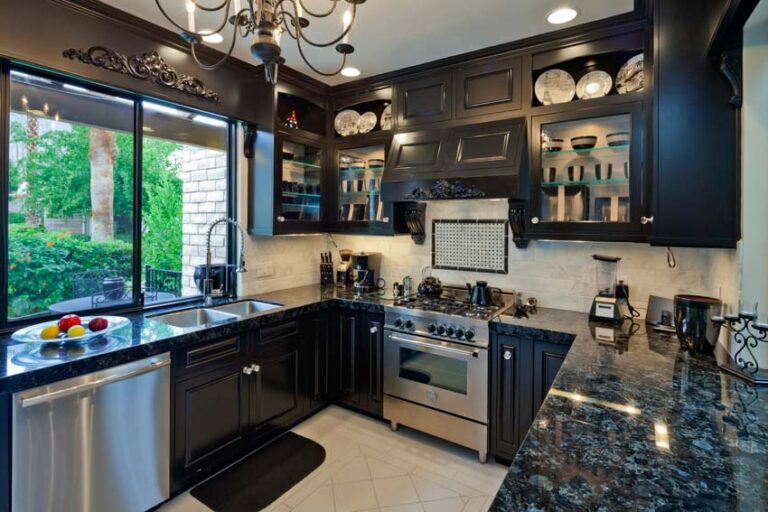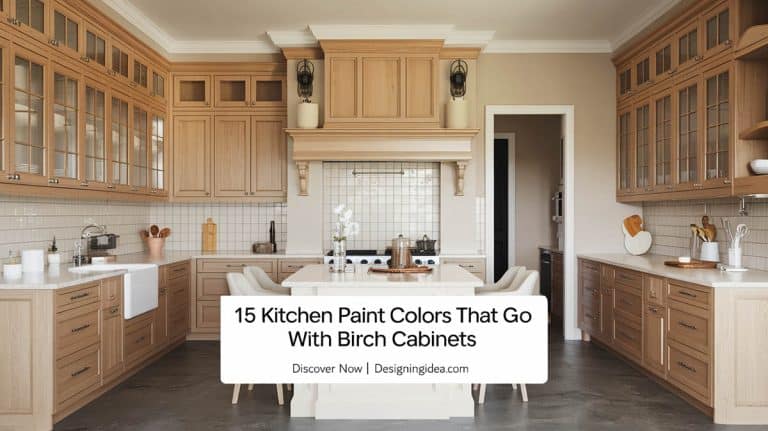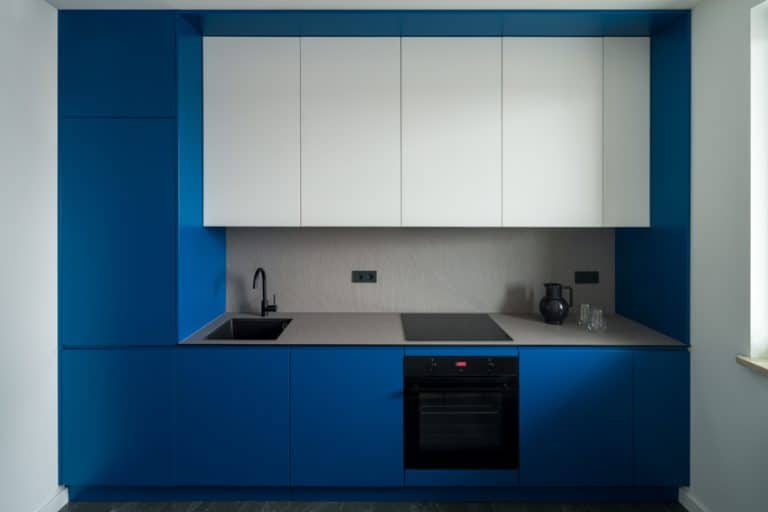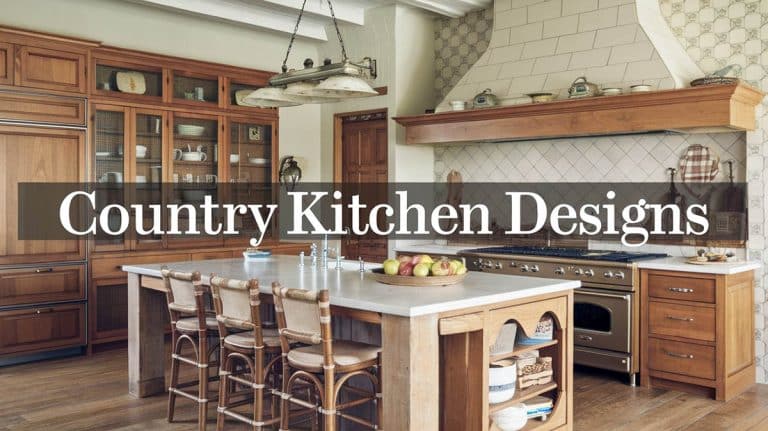Melamine Kitchen Cabinets (Pros and Cons)
This guide to melamine kitchen cabinets includes what they are, the benefits & characteristics of this material, types of grain, pros and cons, and updating melamine cabinets.
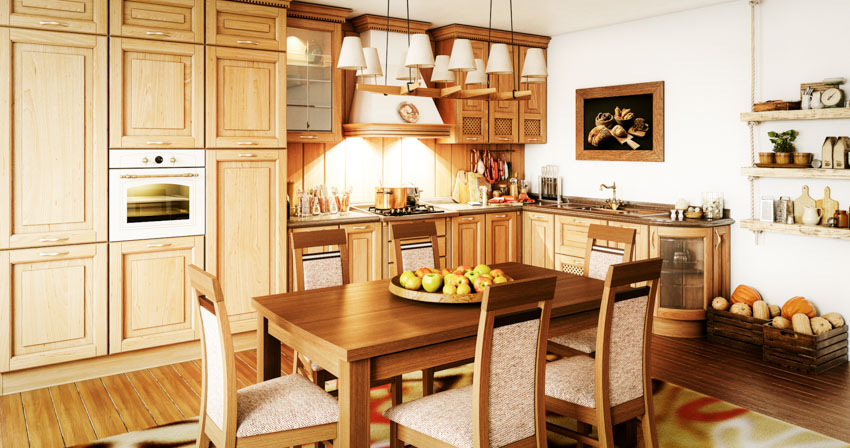
High-quality melamine cabinets are popular because they are more affordable than solid wood cabinets or other alternatives while looking attractive and natural.
What Are Melamine Kitchen Cabinets?
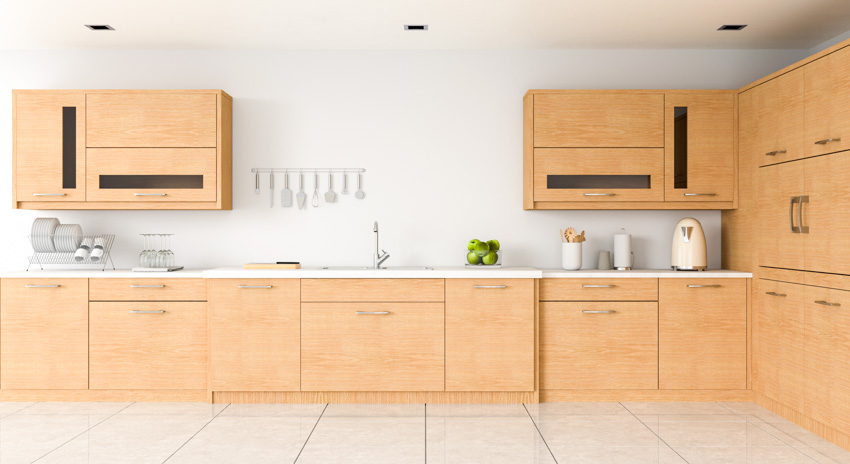
Melamine cabinets’ popularity is due to their boundless and full spectrum of single colors to all simulated finishes. These melamine cabinets reproduce the look and feel of actual paint, wood grain, concrete, metals, or material designs. The cabinet doors typically come in ⅝” or ¾” thicknesses.
Melamine Cabinet Material
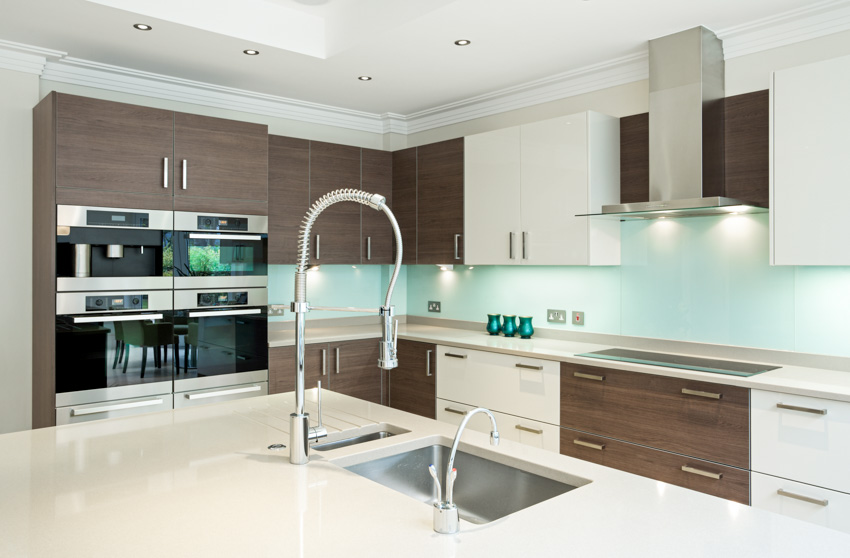
Due to the characteristic of melamine material that hardens when heated, the surface of the decorative cabinet is scratch-resistant, colorfast, and exceptionally durable.
It is similar to particle board; however, melamine is more robust and made using a different process. The melamine used in kitchen cabinetry is an engineered product such as Thermally Fused Melamine (TFM), or High-Pressure Laminate (HPL) is Melamine fused with MDF or Particle Board.
The latter is made from less expensive wood chips, yet as reliable as wood. TFM and HPL melamine laminate types are stain, heat, moisture, and abrasion resistant.
High-Pressure Laminate, compared to Thermally Fused Melamine, is the sturdiest type of laminate. HPL includes layers of kraft paper, which offers a more flexible product and can be applied to more types of substrate boards. It can even be bent for curved surfaces and has a wider variety of design options in terms of colors and patterns.
Compared to High-Pressure Laminate, Thermally Fused Melamine is less expensive and more commonly available. They are slenderer than HPL, so it is much more robust against scratches and chips. However, TFM cannot be bent, but since it is fused directly to the particleboard, it is also peel-resistant. Like HPL, Thermally Fused Melamine also has plenty of design options.
Many homeowners today who are concerned with preserving sustainable resources choose melamine as an alternative to hardwood cabinetry. Melamine has many inherent properties that contribute to its properties, making it fire retardant, resistant to moisture, and warp-proof. It is a competitive choice in any kitchen design concept.
Melamine Wood Grain Cabinets

It also has a three-dimensional effect and provides seamless integration of pattern and color. Textured melamine often has the look of a natural wood grain that can be used to match any kitchen style.
This option is popular because of its durability, resistance to scratching and alterations from sun exposure, and modern look. It is easy to clean and maintain and will not quickly swell when it comes in contact with liquids.
Textured melamine cabinets have a natural wood look and feel, creating a visual and tactile texture in kitchens. The nature-inspired texture of a woodgrain melamine finish adds depth to otherwise flat-looking kitchen cabinetry.
High-End Melamine Cabinets
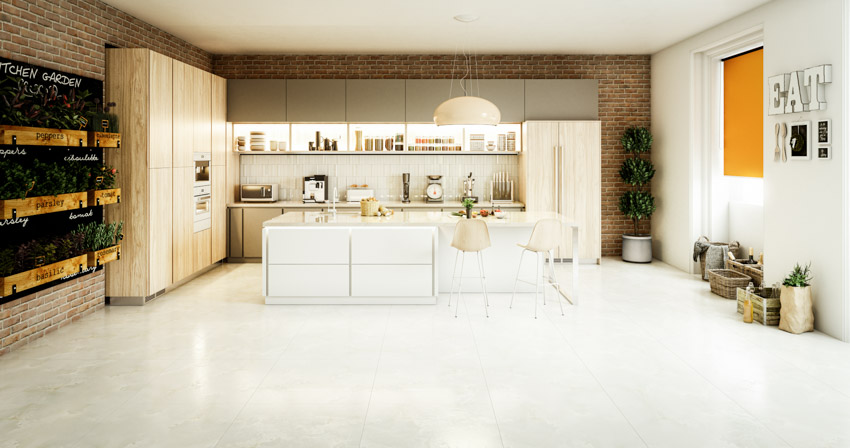
The material’s shiny appeal is also beautiful. Whether you prefer solid, bold colors such as black, red, or stark white, high-end resin-coated cabinetry has got you covered.
For years, melamine was considered cheap and of poor quality. Today, melamine has developed into a popular option for kitchens due to the availability of high-end materials used in manufacturing them.
Laminate Cabinet Pros and Cons

• Durability: This is one of the significant benefits of melamine kitchen cabinets. Melamine cabinets are exceptionally durable and resistant to the usual conditions common in kitchens, such as heat, moisture, and stains, due to their tough outer coating.
Unlike wood, it has a higher heat tolerance than raw wood and prevents shrinking and expanding. Melamine cabinets are harder to scuff and scrape and are designed to withstand exposure to too much heat.
• Maintenance: The smooth surface of these cabinets will make them easy to clean and will not require re-staining or sealing over the years.
• Variety of design: As a synthetic material, melamine cabinets come in various colors and patterns. It is also available in many finishes, including faux wood grain, wood tones, and textured melamine options. It can offer consistent and uniform finishes because it is manufactured within a controlled environment.
• Cost-effective: This material offers a less expensive, durable, and visually attractive option. The standard variety is more cost-effective than premium cabinets made of painted MDF or natural wood. Its cost-effectiveness is why it is such a popular and budget-conscious choice for cabinets.
While melamine has excellent benefits, there are some cons to using this as a material for cabinets.
• Weight: These weigh more than other cabinetry materials. It would require upgrading brackets to more heavy-duty hinges or drawer glides. Not having the proper brackets for hanging can damage your cabinetry and the doors or drawers.
• Installation: It can be more challenging to install since there is a greater risk of splintering the melamine during careless fittings. If splintering, it will show the compressed wood core and can be more susceptible to water damage and moisture penetration. The cabinet’s structural integrity can be compromised because water absorbs into it more easily and quickly than solid wood.
• Susceptible to chipping: While the outer resin coating is durable, it is still susceptible to chipping. When something hard impacts its surface, it can result in chipping or cracking of the surface material. If the cabinets chip, refinishing them or replacement can become expensive.
• Water Damage: If splintering, chipping, or cracking happens to the surface layer, water can make its way to the wood particle core and become saturated. This will do much damage and can weaken the cabinet’s overall structure. Its capacity to absorb water is nowhere near the amount that solid wood does.
• Recycling: The thermoset plastic melamine resin cannot be melted down and recycled. Since it is non-biodegradable, it is not easy to recycle discarded cabinets made from plastic resin.
• Limited Choice Of Shape: Typically, the cabinet shapes are always square, limiting design options, especially when the space requires rounded or curved kitchen cabinets.
Laminate Kitchen Cabinets Price
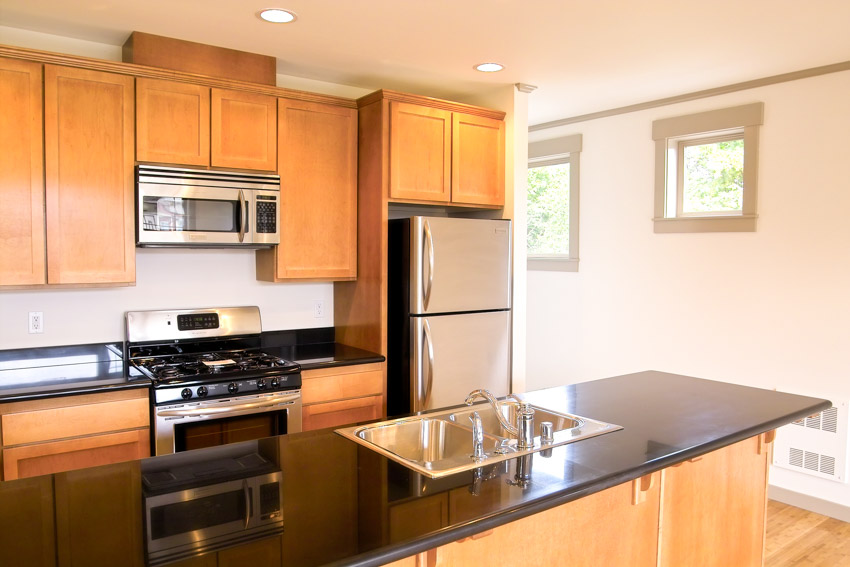
However, aside from the material, such as melamine, the style of cabinets can also be influenced by their cost, including the construction and hardware fitted into cabinet doors or frames.
Another aspect that plays a defining factor in the cost of cabinets is the price per linear foot. To give an overall estimate of the cost, you will need to measure how much cabinetry is required, together with the cabinet’s length, width, and height that need to be calculated.
Due to the thickness and special adhesives used, these cabinets’ average cost is between $60 to $150 per linear foot. The average price of a melamine cabinet, including installation fees, can range from $4000 – $9000. Adding new ones from the said material can rack up to $9,200.
However, the cost will depend on the quality level of the cabinetry, which is available from low-end, mid-range, or high-end kitchen cabinets, depending on the homeowner’s budget.
Colors for Melamine Type Cabinets
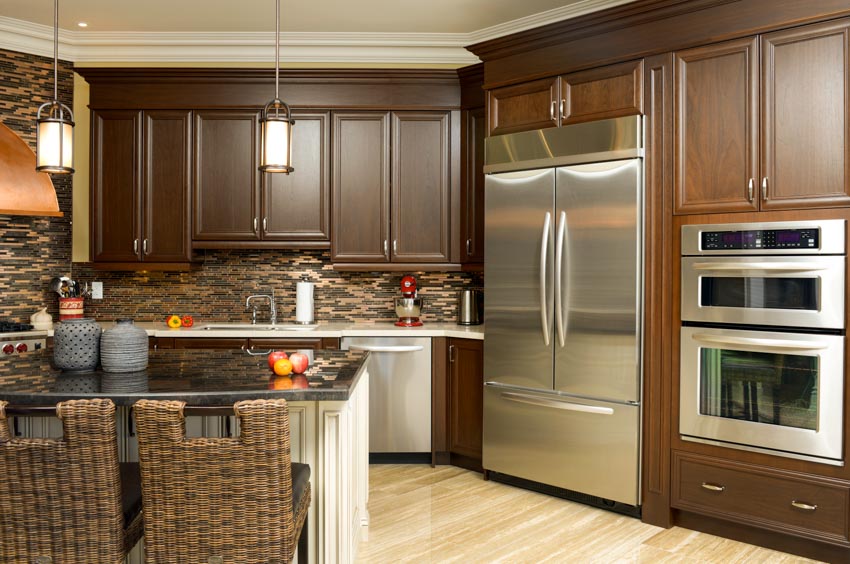
You can match these storage units to any style, personality, or vibe, from sleek blonde wood for a Scandinavian-inspired look to all-white and chrome for an ultra-modern feeling. Light wood-look melamine and solid-colored units combine to produce good cabinet design ideas. It also makes a custom kitchen look modern and gives it a warm home feeling.
These doors offer access to a vast range of colors and finishes. This allows homeowners and designers to create a customized space and will not be restricted by limited options.
From a neutral palette of white, cream, grey, or pale blue to incorporating some vibrant color into the space, it is easy to find the perfect color, shade, and texture with your melamine doors.
Melamine Doors for Cabinets
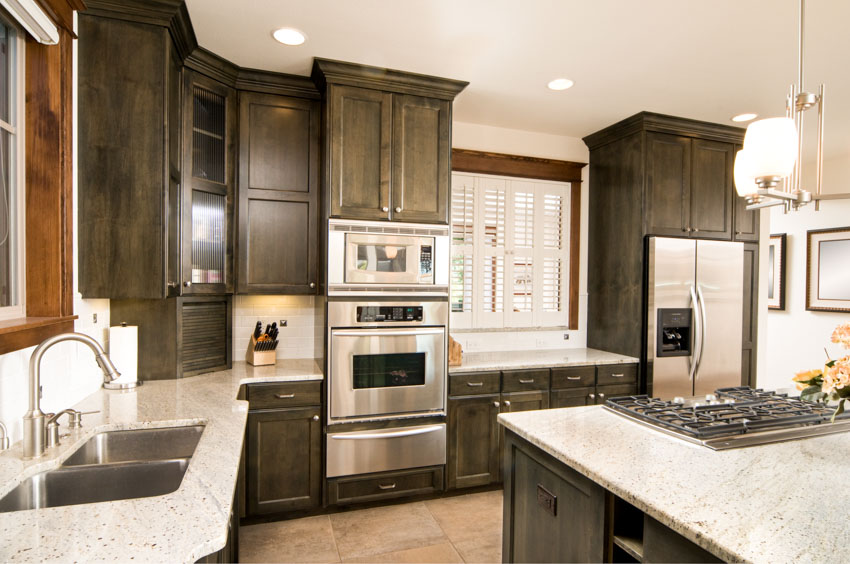
The hard-wearing construction of the cabinet doors allows them to withstand dents, chips, and scratches and prevents doors from fading over time. These cabinet doors are easier to clean. Wipe your cabinet doors with soapy water regularly, then dry them with a soft cloth.
To avoid staining, wipe away food and liquid spills right away. However, avoid using abrasive cleaners or scourers, as this can lead to micro-scratches on the doors. It is also essential to ensure that solid hinges allow you to operate these cabinet doors smoothly.
How to Update Cabinets Made of Melamine

Here are several options you can use for refacing melamine cabinets:
• A few coats of satin, eggshell, or semi-gloss paint is the most common upgrade. Play around with colors such as smoky gray, rich brown, or bold black for drama.
For a country, nautical, or shabby-chic style, paint your cabinetry light aqua or mid-tone green.
For a modern approach, paint only the lower portions in a high-gloss finish with a darker shade than the upper shelving.
• Applying self-adhesive paper is another option; make sure that the patterns match as you cut the pieces to fit on the cabinet frames and doors. Avoid getting any air bubbles under the plastic sheets of the self-adhesive paper.
• Ultra-thin wood veneer or self-adhesive laminate sheets are another way to update them.
• Adding moldings, such as creating a border for a Shaker-style look, is another easy way to give these storage units a face-lift. A beadboard effect can add another dimension when applied over these cabinet doors.
• Incorporating clear or frosted glass doors for the upper cupboards takes much less time and costs significantly less money to replace just the doors.
Painting Melamine Cupboards
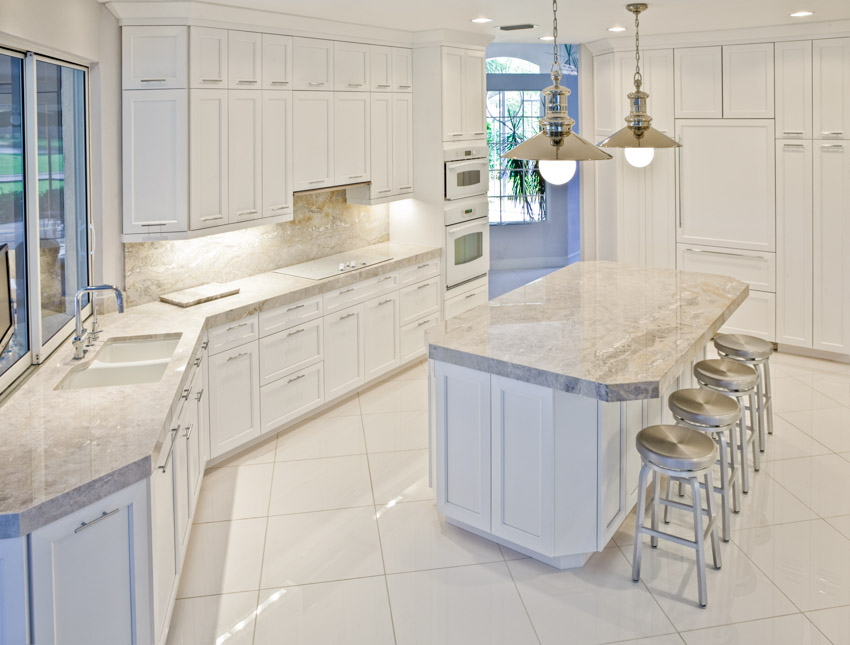
To give any new covering product an excellent surface to bond to the melamine, sanding the cabinetry with medium-grit sandpaper removes the outer surface and roughens the surface. After sanding, remove any dust with a tack cloth.
Make sure to repair any damaged area with paintable putty or filler to even out any gouges, scratches, or nicks. Use a putty knife to spread the filler product and to even out the area until it blends with the surrounding surface. Use a clean, lint-free cloth to wipe around the repaired area before painting.
Remove all cabinet doors, drawer faces, hinges, doorknobs, and drawer pulls. You can cover these types of cabinet hardware entirely with painter’s tape to protect them.
Choosing the right paint and brushes helps you achieve successful results when painting cabinet surfaces made of this material. High-quality latex, acrylic, and chalk paints work well on these surfaces, but most require priming.
Coat the surface of the body, doors, and drawers with a primer. It is essential to let the primer dry, as primers vary in drying time. If the primer does not cure properly, scratches will likely be more noticeable.
Using standard paintbrushes works well because they mimic the flow of the grain. However, since this material is a plastic coating, it is best to use foam rollers and brushes for a brush-mark-free finish when painting this type of cabinetry. Using a spray-paint device for painting will give a completely smooth look and require less work.
After applying the first coat of paint, let it also dry thoroughly before using a paint roller to smooth on your second coat. This way, you can see how much more coverage you need to get the look you want.
Next, add a sealer compatible with your paint and let it properly cure before reinstalling the hardware and putting them back in place.
Cleaning Laminate Storage Cabinets

Next, use a streak-free glass cleaner on a soft cloth to remove residues. Always consider applying cleaning products to the fabric rather than directly on the surface.
If the cabinetry has a textured finish, occasionally use a soft brush to remove dirt build-ups and residues left by some cleaners.
Always wipe up spills as soon as possible by rinsing the surface with cold water and wiping it dry. At times, it might require applying methylated spirits and wiping them dry again.
For suborn marks, apply diluted Janola with a ratio of one part Janola to three parts water; then wipe off with a warm, damp cloth. Fingermarks and stickiness are best removed by applying one or two applications of acetone and wiping them over with a dry cloth.
Methylated spirits or mineral turpentine on a clean cloth or paper towel works best to remove newsprints, felt pens, or dry markers on such surfaces. Duco lacquer thinners or acetone can be used to remove paint, while lemon juice or vinegar will easily remove rust.
Melamine Vs. Wood Cabinets

Resin-coated cabinetry is popularly used to replicate various wood grains and match the surface textures of natural wood aesthetics. Textured melamine allows for deep, consistent wood grain visuals in a synthetic product.
Melamine can accurately replicate many wood grain species and produce a more uniform grain pattern than a natural wood species. At the same time, hardwood, as a natural material, will offer an aesthetic uniqueness that does not come with melamine. Thus, no two storage units will have the same grain pattern.
European textured melamine is considered a higher quality, luxury alternative that produces a distinct material with deeper textures and colors, a more realistic-looking wood grain, and a texture that feels more like natural hardwood.
One of the most desired characteristics of wooden kitchen cabinets is the variety of finishing options available. Wood shows its versatility through the finishes that are applied to it. They can be finished in paint, stain, glaze, or worn and distressed finish, while melamine can only mimic the different finishes printed on a decorative paper fused to a substrate.
There are wide varieties and customization options when choosing to paint wood. However, a painted wood finish can be susceptible to joint cracking since natural wood expands and contracts due to temperature and humidity changes.
Melamine, on the other hand, joint separation will never be an issue since melamine only comes in slab doors and is also not painted when it comes to solid color options.
Stained natural wood cabinetry provides a rich, translucent finish. The knots and natural grain pattern and texture remain visible. Stained wood cabinetry offers a more durable finish that can hide damages or blemishes and is more accessible within those knots and grains.
Unlike melamine, which only comes with predetermined levels of stain and can restrict the overall selection for wood grain designs, natural wood stains have significantly more options. The downside of staining natural wood is that stains seep into the wood and will not always adhere consistently. This can result in an uneven, or even sometimes blotchy, finish.
The beauty of working with natural woods is that the material has unique craftsmanship that cannot be replicated by decor paper and resin coating used in melamine.
Melamine is one of the most durable cabinet materials made with resin-filled paper permanently fused to the particleboard substrate. It will not peel and has a strong resistance to excessive moisture, heat, and stains. Despite this, the underlying substrate is highly vulnerable to water damage when chips, scratches, or other damage occurs.
Natural wood can take significant moisture from changes in temperature and humidity. It can naturally expand and contract, while melamine will not.
There is also a difference in design flexibility between melamine and natural wood. The former is restricted to always come in a slab or flat door style. With natural wood cabinetry, there is always the opportunity to modify or customize the design.
Melamine is considered cost-effective and a popular, budget-conscious choice. Alternatively, the price of natural wood cabinetry will vary depending on the wood species and the finish.
Laminates Vs MDF Cabinets
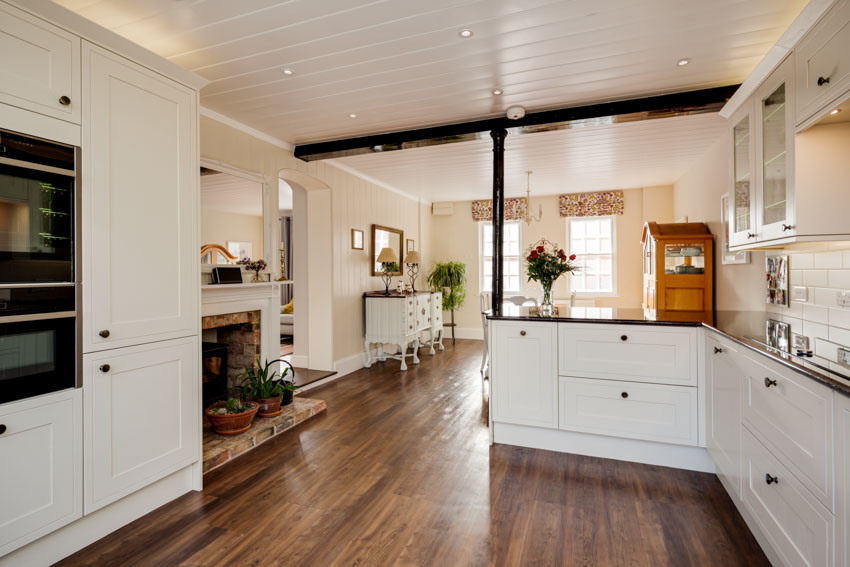
Medium Density Fiberboard (MDF) is made of engineered wood fibers blended with wax and a resin binder, applying high pressure and temperature forging it into panels. This composite material provides surface resistance from water, termites, and other elements that can damage the boards.
Different fiberboards are manufactured in various degrees of temperature and pressure. They are then categorized into several densities of the material. The MDF material is between HDF (High-Density Fiberboard) and particleboard in terms of density.
Usually, these boards have MDF as the core material or substrate for extreme durability. However, it is a more water-resistant type of particleboard and stronger than MDF. It is also more cost-efficient than MDF.
Though both materials are manufactured wood products and share many component ingredients, the manufacturing processes are slightly different. Melamine laminate is a hard, plastic product, while MDF doesn’t include any plastics.
Melamine is manufactured by combining a resin with formaldehyde, while MDF is wood fibers bonded with synthetic resin under high heat pressure to make strong boards.
It is more robust, durable, and scratch-resistant than MDF due to the extra coat of hard plastic. It is highly waterproof, while MDF readily absorbs water and moisture and is prone to damage. However, MDF can be sealed to make it waterproof and protect the boards from everyday moisture.
Both materials accept nails and screws readily, but MDF doesn’t hold onto nails as well as melamine resulting in a weak hold. Both have a certain degree to which each surface can be worked or finished. MDF cannot be sanded but takes paints better. On the other hand, melamine can be lightly sanded and easily painted.
It has a more significant advantage than MDF in terms of flexibility. Although it is not the most flexible material, it can bend melamine to a small degree without cracking the board. The thinner the melamine board, the further it can bend; unlike MDF, any slight attempt to bend MDF usually results in cracking and breaking.
Since both are made from solid wood waste, they are sustainable and provide an excellent way to repurpose waste wood. MDF kitchen cabinets have a more significant advantage; made of 82% wood fibers and 8% water, MDF is more environmentally friendly and sustainable. MDF is more natural, safe, and 90% recyclable.
On the other hand, melamine isn’t too bad either, but its plastic laminate is not as environmentally friendly. Finally, although both melamine and MDF boards are more economical than solid wood, MDF is more affordable than melamine.
Melamine Or Laminate As Cabinets
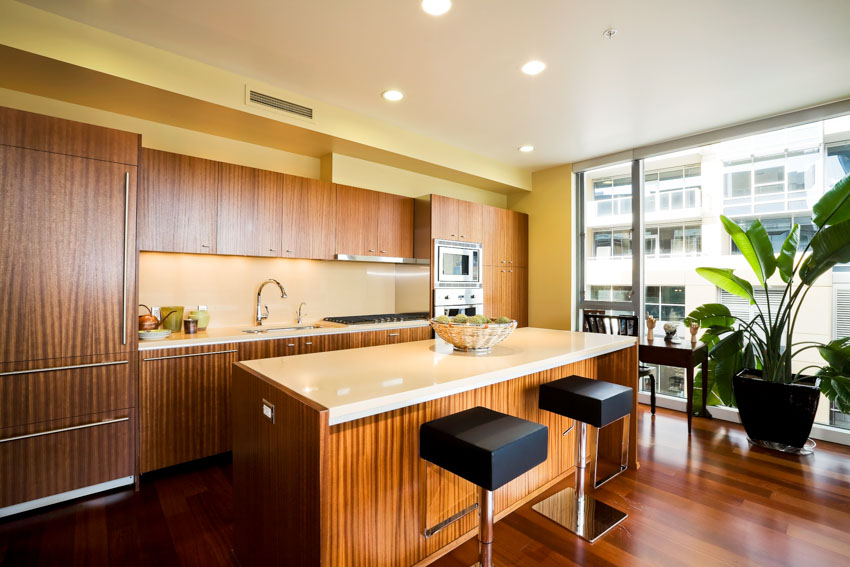
Melamine is referred to as direct-pressure or low-pressure laminate produced with a pressure of just 300-500 psi. Laminate is also called high-pressure laminate (HPL) and is popularly known by the name Formica.
For making laminates, an extremely high pressure of 1400psi is required to use over 6-8 layers of resin-impregnated kraft paper, decorative paper, and a clear overlay. With this manufacturing process for both materials, melamine is cheaper than laminate by a method that is not cost-intensive.
Laminate is more durable and resistant to heat and chemicals, although HPL is more susceptible to chip and crack than a low-pressure laminate. HPL is a material that can be used for both horizontal and vertical applications such as counters and drawers.
Laminate has a higher level of impact resistance, making it great for high-traffic areas. Melamine, on the other hand, is best suited for vertical, low-impact, or low-wear applications such as shelves.
Laminates can be customized and are resistant to abrasion, impact, and scratches. They are also easily maintained and very hygienic. HPLs are available in many colors and finishes and can bond to various substrates and a wide range of thicknesses.
As for price difference, this material is cheaper than HPL since it undergoes far less factory manufacturing and offers a better cost. HPL performs at a higher level than melamine, being malleable and can be used for curved or rolled applications, which is why HPL sits in a higher price bracket.
In a nutshell, achieving the best cabinet design for your home starts with understanding the differences in qualities, features, and costs, including the pros and cons of resin-coated cabinetry compared to other materials available in the market.
Hopefully, at this point, you have a clearer understanding of the characteristics of melamine, and it will be easier for you to achieve your custom cabinetry need.
See more related content in our article about lacquer cabinetry on this page.

